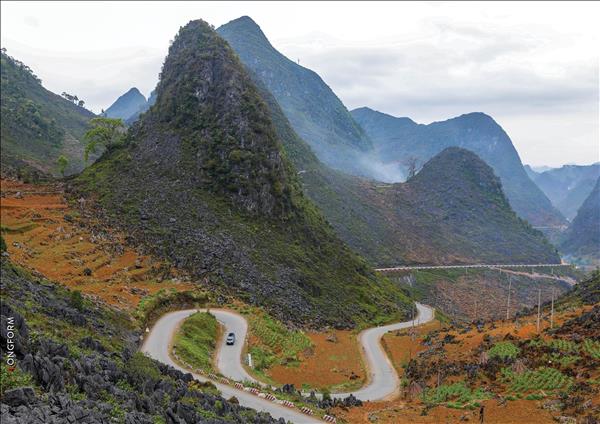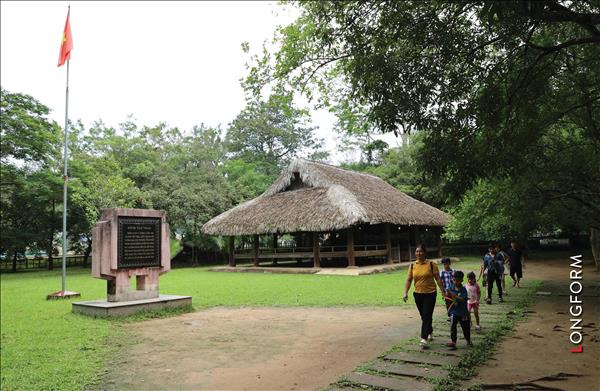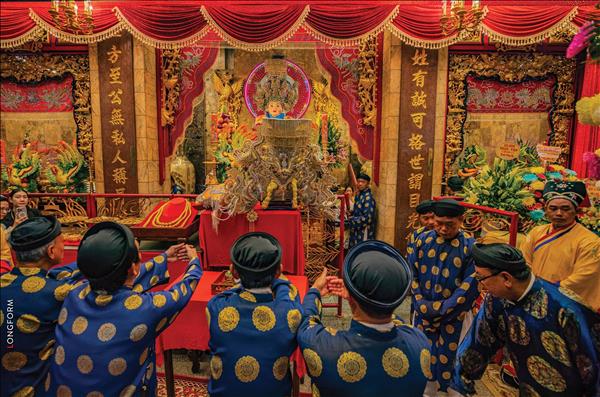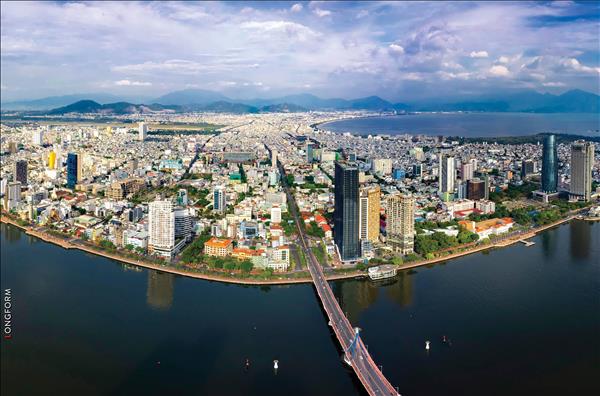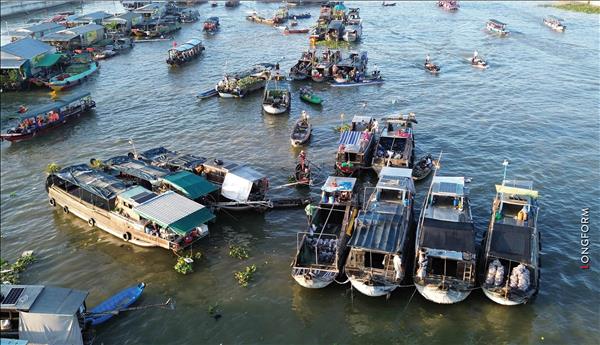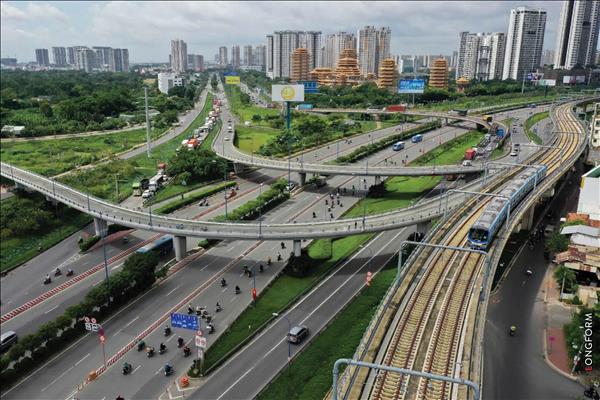Strength of the border region
We visited the border province of An Giang in southern Vietnam in the spring 2017. Along the roads leading to the border gate with the neighbouring country of Cambodia, there are communes and small hamlets residing peacefully near fertile vast fields and rows of palm trees - typical images of this southwestern region.
Chau Doc city, located about 25km from the border with Cambodia, is seen as the main town of the An Giang border region. The city is significant in terms of economy, trade and tourism, attracting over four million domestic and foreign visitors to visit for sight-seeing, shopping and convalescence.
From Chau Doc, we took National Highway 91C to An Phu border district, which has KhanhBinh border gate with Cambodia by both road and water. Standing on the banks of the Binh Di river on the Vietnamese side, we could see the Chrey Thum border gate of the KohThum district of Cambodia’s Kan Dal province. For a long time, Long Binh town of An Phu district has been the destination for commodities, including agricultural products, clothes, cosmetic items and food to gather and then to be transported to Vietnam and Cambodia.
From boundary milestone 246 located at the Binh Di river confluence in Long Binh town, we could see boats transporting passengers to/from both sides of the river. In the near future, when the Long Binh-Chrey Thom bridge is completed, it will work as a lever to boost both side’s economy, and promote relations and cooperation between people of the two countries.
Meanwhile, Tinh Bien town of Tinh Bien district is considered a centre of An Giang province’s border trade. The Tinh Bien International Border Gate with Cambodian Phnom Den Border Gate in Ta Keo province is the point of junction between Vietnam’s National Highway 91 and Cambodia’s National Highway 2. From here, produce and other commodities can be transported to Phnom Penh, or through Kampot province and along Highway 3 to Poset, Odong, Kampong Speu and other places very conveniently. Each year, the export trade turnover through this border gate reaches over 100 million US dollars. This is a great advantage for An Giang province towards building Tinh Bien district into a border economic zone, helping further develop Vietnam’s entire southwestern border region.
Khanh An commune in An Phu district is another strong location in An Giang province in terms of standardising targets in building new rural areas. It has networks of infrastructure, electricity, schools and medical clinics, which made it become the first unit with the title “new rural area” in An Phu border district.
Huynh Tien Luan, Vice Chairman of Khanh An commune People’s Committee, said that although the commune started developing at a lower level compared with other localities, the local villagers had tried their best to build their commune. After five years, they had completed the set targets for building “a new rural area”, and their economic and cultural life had been improved remarkably.
In Vinh Xuong commune of Tan Chau district, we visited the home of Le Thi Lan in hamlet 3. Thanks to investment in breeding goats for meat and growing guavas, she has developed her family’s economy strongly.
“I just sold five goats, worth 20 million dong, so I could prepare for my family’s welcoming Tet,” she said, showing us the herd of strong goats on her farm.
In hamlet 5, Nguyen Van Minh and his family cultivated mushrooms, and every month he earned more than 30 million dong. Seeing that his business ran well, the commune’s Farmers Association helped him borrow money from the local bank to expand his farm.
Great changes for the better are taking place in An Giang border province. Many communes have reached the honoured titles, such as a “new rural border area”, or a “cultural border area”. Each locality has its own strong point in development, but all share the common feature that together they have tried their best in developing their native place in the far-off southwestern border region of the country.
Close relations among people in the border region
An Giang province is home to many ethnic groups including the Kinh, Cham, Khmer and Hoa, who follow different religions such as Buddhism, Hoa Hao Buddhism, Caodaism, Catholicism, and Protestant. The province has over a 100km long border with Cambodia, which may create complicated security and social order, including social evils, human trade, smuggling, and others. With high determination, the border guards of An Giang province in coordination with security forces have implemented their task of ensuring security in the border area and helping people from the two countries live and work conveniently.
There are 12 border posts in An Giang province, including two international border gates and two domestic border gates.
Captain Nguyen Duc Thang, Commissar of the Training-Mobile Battalion of An Giang province’s Border Guards, said that the local people had special attention and deep feelings for the soldiers, considering them their own relatives.
“The border guards help local villagers a lot, from ensuring security for their life, building local roads, teaching children, providing medical check-ups and medicine, to growing vegetables and carrying water,” said Captain Thang.
When we were in Nhon Hoi commune of An Phu district, the Lunar New Year 2017 was approaching. The border guards joined local people in making Banhchung (traditional sticky rice square cakes) and preparing artistic performances held during Tet holidays. Others kept teaching the children or visiting local sick villagers, giving them medical check-ups and medicine.
In Van Giao commune of Tinh Bien district, where many ethnic Khmer people reside and formerly was the poorest locality in An Giang province, we saw many changes for the better. New houses, roads and schools were built, and an electricity network installed. Van Giao villagers restored their traditional craft of weaving brocade, making it the main economy of the commune.
NeangSamon in SraySkoth hamlet said that thanks to the support and help from the local leaders, her family and others in the hamlet could develop the brocade weaving craft, from which she earned enough money to build a new house and buy food for her family, and her children could go to school. “Our life at present is much better than that in the past,” she said with satisfaction.
The province’s leaders have not only helped local people develop the economy, but also paid attention to improve the latter’s spiritual life by providing favourable conditions to them to preserve their traditional culture and practice their religion. That’s why people of different ethnic groups in the province together live in love and peace and they are free to preserve their own cultural characteristics. Pagodas, temples and churches were built or renewed, and traditional festivals and competitions were organised annually, of which some have become famous events nationwide.
Exchange in trade and daily activities between Cambodian and Vietnamese people along the common border region help them improve their economic life.
When we visited Tinh Bien International Border Gate, we talked with Chao Soc Hum, a trader from Cambodia. He said almost every day he went to the Vietnamese side two or three times to purchase produce and transport it to Cambodia for sale at markets in Takeo province. He also said that he had many Vietnamese friends and trade partners.
Tran Van Buol from KhanhBinh commune of An Phu district, who has been doing business in this border area for a long time, said that most people living along the two sides of the border gate could speak both Vietnamese and Cambodian, hence their exchange of goods and business ran well and was fruitful.
To build a friendly and peaceful border in order to help the local people stabilise their lives, residents living along the common border have established twin communities, while the border guards from both sides have promoted their exchange of meetings and visits to strengthen their friendship and solidarity.
The border guards of An Giang province and Cambodia’s Kan Dal and Ta Keo provinces regularly coordinate in organising common patrols. When there is anything happening, they inform each other and together solve the problem in line with mutual policies through reasonable and legitimate ways, which would never let tension occur.
Besides the network of medical stations located in border communes, An Giang border guards set up three more military medical clinics in Tri Ton, An Phu and Tan Chau districts to enhance the capacity of checking and treating diseases for the local people.
An Giang border guards’ medical staff hold check-ups and provide medicine free of charge, to thousands of Cambodian residents in Ta Keo and Kan Dal provinces. Experienced and qualified doctors from Ho Chi Minh City, Chau Doc and Long Xuyen cities go to perform medical check-ups and treatment for people living on the border from both countries, with the spirit of “special compassion between Vietnam’s and Cambodia’s border regions”.
Our stay in An Giang province passed so quickly. We left Tinh Bien border gate in the afternoon full of golden sunshine. Through the car windows, we saw hamlets and rows of palm trees passing by, so peacefully and in tranquility. A new spring was truly coming to the country’s southwestern border region with its new vitality.
We visited the border province of An Giang in southern Vietnam in the spring 2017. Along the roads leading to the border gate with the neighbouring country of Cambodia, there are communes and small hamlets residing peacefully near fertile vast fields and rows of palm trees - typical images of this southwestern region.
Chau Doc city, located about 25km from the border with Cambodia, is seen as the main town of the An Giang border region. The city is significant in terms of economy, trade and tourism, attracting over four million domestic and foreign visitors to visit for sight-seeing, shopping and convalescence.
From Chau Doc, we took National Highway 91C to An Phu border district, which has KhanhBinh border gate with Cambodia by both road and water. Standing on the banks of the Binh Di river on the Vietnamese side, we could see the Chrey Thum border gate of the KohThum district of Cambodia’s Kan Dal province. For a long time, Long Binh town of An Phu district has been the destination for commodities, including agricultural products, clothes, cosmetic items and food to gather and then to be transported to Vietnam and Cambodia.
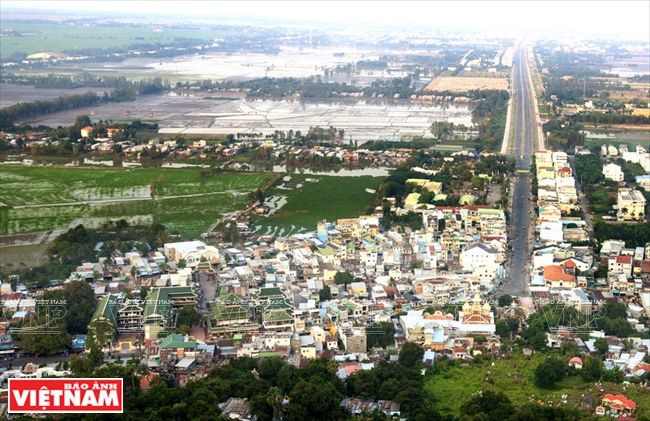 Part of Chau Doc city, An Giang province seen from Sam mountain. Photo: Thong Hai 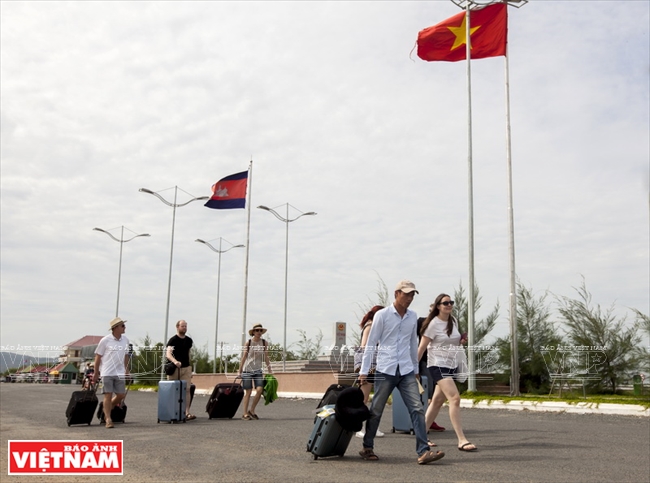 Tourists travel through the Tinh Bien International Border Gate. Photo: Thong Hai  Foreign tourists on a trip from Cambodia to Vietnam by waterway Foreign tourists on a trip from Cambodia to Vietnam by waterwaythrough the Tien River International Border Gate. Photo: Thong Hai Cadres and soldiers of the border post of the Long Binh International Border Gate (under the Border Guard of An Giang province) and Cambodian border guard implement a joint patrol on the Hauriver (this sector runs through Long Binh town and Khanh An commune, An Phu district). Photo: Nguyen Duc Thang |
| An Giang province has many border gates with Cambodia, including the Tinh Bien International Border Gate (in Tinh Bien town) for road transportation, and the Song Tien International Border Gate (in Vinh Xuong commune, Tan Chau town) for waterway transportation. |
Meanwhile, Tinh Bien town of Tinh Bien district is considered a centre of An Giang province’s border trade. The Tinh Bien International Border Gate with Cambodian Phnom Den Border Gate in Ta Keo province is the point of junction between Vietnam’s National Highway 91 and Cambodia’s National Highway 2. From here, produce and other commodities can be transported to Phnom Penh, or through Kampot province and along Highway 3 to Poset, Odong, Kampong Speu and other places very conveniently. Each year, the export trade turnover through this border gate reaches over 100 million US dollars. This is a great advantage for An Giang province towards building Tinh Bien district into a border economic zone, helping further develop Vietnam’s entire southwestern border region.
Khanh An commune in An Phu district is another strong location in An Giang province in terms of standardising targets in building new rural areas. It has networks of infrastructure, electricity, schools and medical clinics, which made it become the first unit with the title “new rural area” in An Phu border district.
Huynh Tien Luan, Vice Chairman of Khanh An commune People’s Committee, said that although the commune started developing at a lower level compared with other localities, the local villagers had tried their best to build their commune. After five years, they had completed the set targets for building “a new rural area”, and their economic and cultural life had been improved remarkably.
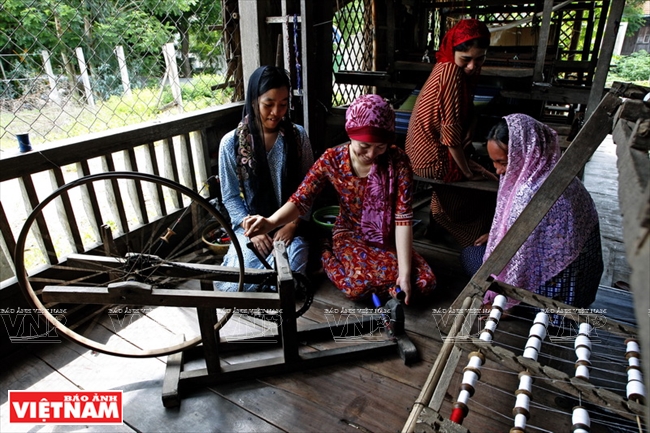 Cham women in PhumXoai hamlet, Chau Phong commune, Tan Chau district with their traditional weaving loom. Photo: Minh Quoc  Harvesting rice in Van Giao commune, Tinh Bien district. Photo: Kim Son 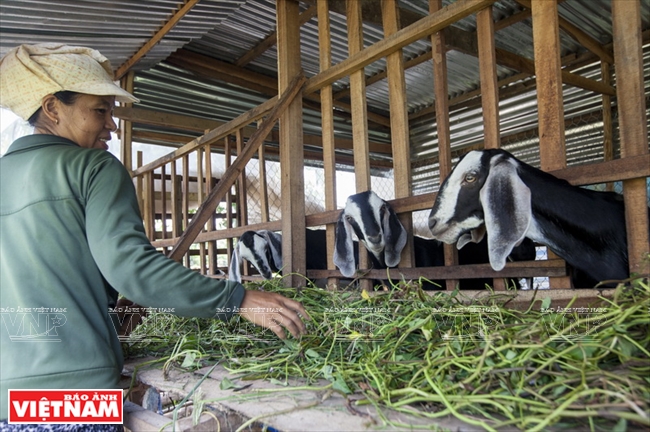 Le Thi Lan family in hamlet 3, Vinh Xuong commune, Tan Chau district makes money by raising goats. Photo: Thong Hai Dinh Hung Cuong family in Long Giang commune, Cho Moi district engages in the local craft of weaving bamboo baskets. Photo: Kim Phuong 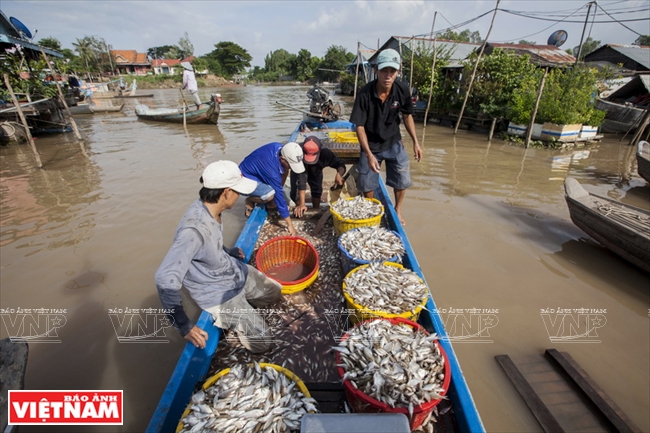 Vietnamese and Cambodian people trading fish on the river in An Khanh commune, An Phu district. The other bank of the river is on the Cambodian side. Photo: Thong Hai  A village raising fish in cages on the Chau Doc River has become a charming destination in Chau Doc. Photo: Thong Hai |
In Vinh Xuong commune of Tan Chau district, we visited the home of Le Thi Lan in hamlet 3. Thanks to investment in breeding goats for meat and growing guavas, she has developed her family’s economy strongly.
“I just sold five goats, worth 20 million dong, so I could prepare for my family’s welcoming Tet,” she said, showing us the herd of strong goats on her farm.
In hamlet 5, Nguyen Van Minh and his family cultivated mushrooms, and every month he earned more than 30 million dong. Seeing that his business ran well, the commune’s Farmers Association helped him borrow money from the local bank to expand his farm.
Great changes for the better are taking place in An Giang border province. Many communes have reached the honoured titles, such as a “new rural border area”, or a “cultural border area”. Each locality has its own strong point in development, but all share the common feature that together they have tried their best in developing their native place in the far-off southwestern border region of the country.
Close relations among people in the border region
An Giang province is home to many ethnic groups including the Kinh, Cham, Khmer and Hoa, who follow different religions such as Buddhism, Hoa Hao Buddhism, Caodaism, Catholicism, and Protestant. The province has over a 100km long border with Cambodia, which may create complicated security and social order, including social evils, human trade, smuggling, and others. With high determination, the border guards of An Giang province in coordination with security forces have implemented their task of ensuring security in the border area and helping people from the two countries live and work conveniently.
There are 12 border posts in An Giang province, including two international border gates and two domestic border gates.
Captain Nguyen Duc Thang, Commissar of the Training-Mobile Battalion of An Giang province’s Border Guards, said that the local people had special attention and deep feelings for the soldiers, considering them their own relatives.
“The border guards help local villagers a lot, from ensuring security for their life, building local roads, teaching children, providing medical check-ups and medicine, to growing vegetables and carrying water,” said Captain Thang.
 Say Ta Som pagoda in Tinh Bien district. Photo: Nguyen Nham 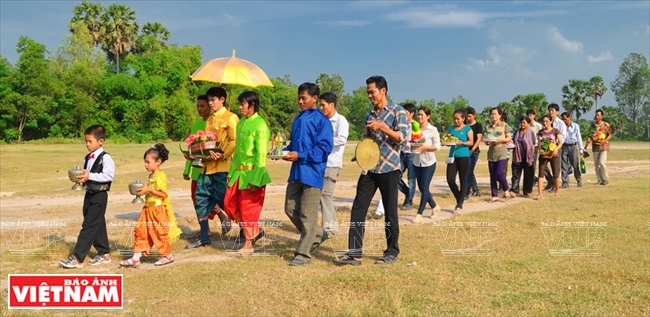 A wedding and the custom of taking the groom to the bride’s family of the Khmer people in Tinh Bien district. Photo: Nguyen Nham 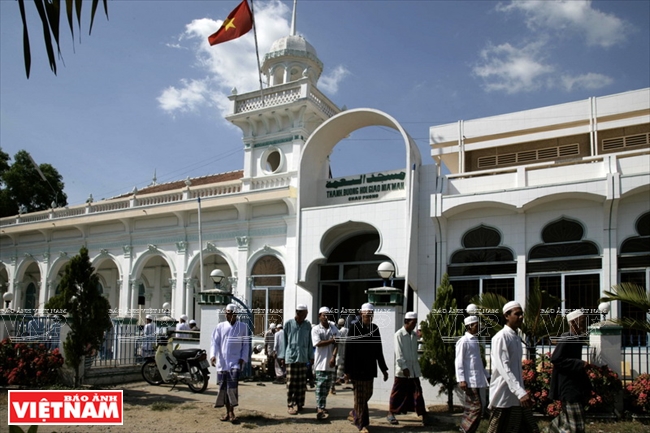 After a ceremony at the mosque of the Cham people in Chau Phong commune, Tan Chau district, An Giang province. Photo: Minh Quoc Harvesting Bong sung (Nymphaea) during the flood season in An Giang. Photo: Minh Quoc 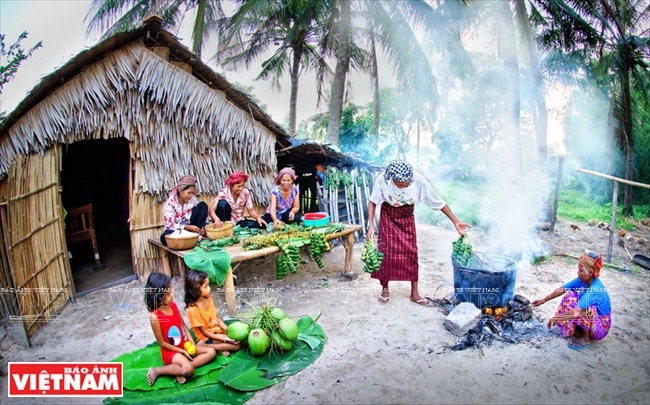 Khmer people celebrate the Vietnamese traditional Tet. Photo: Nguyen Nham Khmer people celebrate the Vietnamese traditional Tet. Photo: Nguyen Nham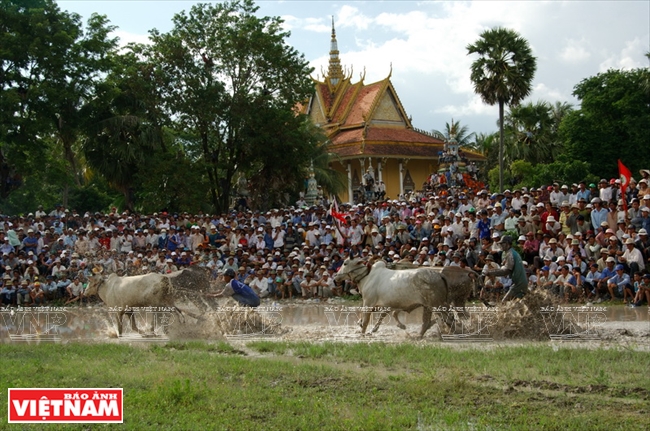 The Bay Nui Cow Race Festival of the Khmer people in Tinh Bien district, An Giang province. Photo: Kim Son The Tra Su cajuput forest in Tinh Bien district is a submerged forest in the South and a famous destination for tours in An Giang province. Photo: Nguyen Thang |
When we were in Nhon Hoi commune of An Phu district, the Lunar New Year 2017 was approaching. The border guards joined local people in making Banhchung (traditional sticky rice square cakes) and preparing artistic performances held during Tet holidays. Others kept teaching the children or visiting local sick villagers, giving them medical check-ups and medicine.
| An Giang province plays a strategic role in Vietnam’s southwestern region. It has a border line of nearly 100km long with Cambodia’s Ta Keo and Kan Dal provinces. AnGiang province is home to many ethnic groups, mostly the Khmer, Cham and Chinese, who follow different religions such as Buddhism, Hoa Hao Buddhism, CaoDaism, Catholicism and Protestant. |
NeangSamon in SraySkoth hamlet said that thanks to the support and help from the local leaders, her family and others in the hamlet could develop the brocade weaving craft, from which she earned enough money to build a new house and buy food for her family, and her children could go to school. “Our life at present is much better than that in the past,” she said with satisfaction.
The province’s leaders have not only helped local people develop the economy, but also paid attention to improve the latter’s spiritual life by providing favourable conditions to them to preserve their traditional culture and practice their religion. That’s why people of different ethnic groups in the province together live in love and peace and they are free to preserve their own cultural characteristics. Pagodas, temples and churches were built or renewed, and traditional festivals and competitions were organised annually, of which some have become famous events nationwide.
Exchange in trade and daily activities between Cambodian and Vietnamese people along the common border region help them improve their economic life.
When we visited Tinh Bien International Border Gate, we talked with Chao Soc Hum, a trader from Cambodia. He said almost every day he went to the Vietnamese side two or three times to purchase produce and transport it to Cambodia for sale at markets in Takeo province. He also said that he had many Vietnamese friends and trade partners.
Tran Van Buol from KhanhBinh commune of An Phu district, who has been doing business in this border area for a long time, said that most people living along the two sides of the border gate could speak both Vietnamese and Cambodian, hence their exchange of goods and business ran well and was fruitful.
To build a friendly and peaceful border in order to help the local people stabilise their lives, residents living along the common border have established twin communities, while the border guards from both sides have promoted their exchange of meetings and visits to strengthen their friendship and solidarity.
The border guards of An Giang province and Cambodia’s Kan Dal and Ta Keo provinces regularly coordinate in organising common patrols. When there is anything happening, they inform each other and together solve the problem in line with mutual policies through reasonable and legitimate ways, which would never let tension occur.
Besides the network of medical stations located in border communes, An Giang border guards set up three more military medical clinics in Tri Ton, An Phu and Tan Chau districts to enhance the capacity of checking and treating diseases for the local people.
|
Doctors of the An Giang General Hospital give free medical treatment to people in the border district of Ta Keo, Cambodia. Photo: Nguyen Duc Thang A class held by soldiers of the border post for Cham children in Nhon Hoi commune, An Phu district, An Giang province. Photo: Nguyen Duc Thang Performing the Sadam dance at the traditional festival of Khmer people in Tinh Bien district, An Giang province. Photo: Nguyen Nham 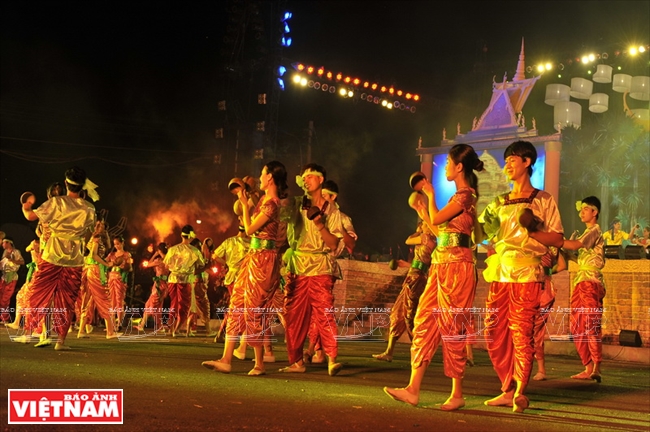 A performance expresses the typical features of Khmer people on the 5th culture, sports and tourism festival of Khmer people in the South, held in Tinh Bien district, An Giang province. Photo: Kim Phuong Cham children after a ceremony at the Chau Phong Muslim Mosque in Tan Chau district, An Giang province. Photo: Minh Quoc |
An Giang border guards’ medical staff hold check-ups and provide medicine free of charge, to thousands of Cambodian residents in Ta Keo and Kan Dal provinces. Experienced and qualified doctors from Ho Chi Minh City, Chau Doc and Long Xuyen cities go to perform medical check-ups and treatment for people living on the border from both countries, with the spirit of “special compassion between Vietnam’s and Cambodia’s border regions”.
Our stay in An Giang province passed so quickly. We left Tinh Bien border gate in the afternoon full of golden sunshine. Through the car windows, we saw hamlets and rows of palm trees passing by, so peacefully and in tranquility. A new spring was truly coming to the country’s southwestern border region with its new vitality.
Story: Nguyen Oanh - Photos: Thong Hai, Nguyen Duc Thang, Nguyen Nham & VNP’s files

